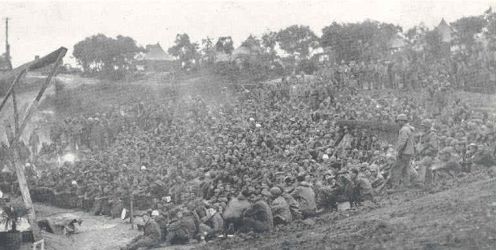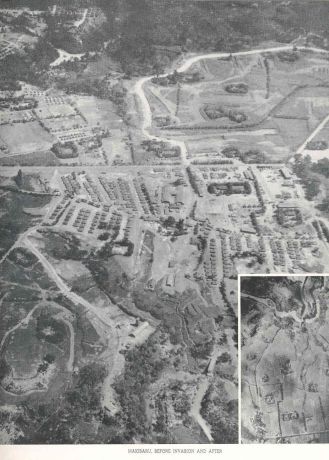
Vern Ingraham of Denver, CO. has been assisting his father, Gerald Bert Ingraham assemble his autobiography. While researching his father's service during World War II, Vern contacted the 623rd AC&W Assn Archives for information regarding Camp Bishigawa. They suspected that a camp his father's unit constructed in April 1945, named "Camp Makibaru" became our Camp Bishigawa. The Archive Committee Chairman has confirmed that they were the same!
A Seabee with the 130th Naval Construction Battalion, Gerald was aboard one of the ships that participated in the feint invasion on the southern coast of Okinawa on 1 April 1945. On that day, the 1st Marine Division stormed the Blue and Yellow Beaches between Yomitan Airfield and the Bishi River. While they met little resistance, they did have more difficult terrain than the US Army 7th Division south of the Bishi River, which overran Kadena Airfield that day. The 1st Marines halted the first night at a line between the towns of Makibaru and Irramiya. More correctly, the districts of Makibaru and Irramiya.
To clarify; The term "township" would be a better word than "town", which implies a community.  There are many townships or "districts" within a larger unit, such as a city, or what we call a county. Some have villages and even actual towns within them, while others are rural and may only have scattered farm structures.
There are many townships or "districts" within a larger unit, such as a city, or what we call a county. Some have villages and even actual towns within them, while others are rural and may only have scattered farm structures.
Makibaru was and is a rural "town" that includes the open area that became our Camp Bishigawa. The district of Makibaru was farm land with small coral and tree surrounded enclosures that protected the farm structures contained within from the annual assault by typhoons. Occupied the first day of the invasion, Makibaru has since remained under U.S. military control. Land owners in Makibaru are paid annually for land under military control. Where possible, those areas in Makibaru not deemed sensitive (i.e. "Restricted") are open during daylight hours for property owners to farm.
Camp Bishigawa veterans may recall the village of China a few miles north of Bishigawa on Highway 1. That is where they went to take an alternate route up to Yontan mountain when the Bishi River was flooded. China falls within the district of Irramiya. So, the Marines halted on 1 April 1945 along a line between our Bishigawa and China.
On 12 April 1945, the 130th Naval Construction Battalion landed on Green Beach near Yomitan Airfield and went to work unloading the LST's. Gerald came ashore on 13 April, going on to the campsite in Makibaru where the Seabees dug foxholes.  Over time these evolved into pup tents and pyramid tents and even a few Quonsets. It was named "Camp Makibaru". The 130th was assigned to bridge and road work, in addition to major work on Yontan Airfield. They put in the Bailey bridges over the Bishi river and worked on Kadena Circle.
Over time these evolved into pup tents and pyramid tents and even a few Quonsets. It was named "Camp Makibaru". The 130th was assigned to bridge and road work, in addition to major work on Yontan Airfield. They put in the Bailey bridges over the Bishi river and worked on Kadena Circle.
Camp Makibaru can be seen in the aerial view of the eastern half of the camp taken in 1945. The blown bridge over the Bishi River can be seen at the south end of the camp. The Mess Hall is the
"H" shaped quonset in the center and the amphitheater is just below it.
For troop entertainment, an outdoor theater, with sandbag seating, was constructed in what was called "Jakes Bowl". The idea seems to have come from the similar "Bowl" at the units old location in Hawaii. They named this one after the Battalion's Chaplain, Chaplain Jacobson. Dedicated on 29 May 1945 with a program for the Seabees, it was to become the "Comet Theater" in later years. Located between Kadena and Yontan Airfields, programs held in mid-1945 were often interrupted by air raids when enemy aircraft flew between those airfields.
While not forgetting the USMC for initially taking Makibaru, we have to give a Salute to the 55,000 hard working Seabees that pulled Okinawa into the 20th Century with roads, bridges, base infrastructures, ports, hospitals and airfields. Also for the shelter and humanitarian facilities needed by the civilian victims and so very much more. The Seabee's from the 130th began rotating home in late 1945 and the unit faded into history. Newer arrivals were assigned to new Occupation Constuction Battalions that continued the fine work started by the SeaBees.
A special thanks to Gerald Ingraham for the part he played in it and for sharing this treasure of information with us all. Our Association will recieve a copy of his completed autobiography, at which time more details and pictures will become available.
Contributed by
Dave Law
Photo's provided by; Comthe.jpg 623rd AC&W Assn Website, Makibaru and Amphatheater 3 by Vern Ingraham.
Edited and posted to the 623rd AC&W site by J London. [KG]